High-Efficiency and Wide-Angle Versatile Polarization Controller Based on Metagratings
Abstract
:1. Introduction
2. Theory and Structure Design
3. Results and Discussion
4. Conclusions
Author Contributions
Funding
Conflicts of Interest
References
- Born, M.; Wolf, E. Principles of Optics, 7th ed.; Cambridge University Press: Cambridge, UK, 1999; pp. 109–132. [Google Scholar]
- Zhou, J.; Dong, J.; Wang, B.; Koschny, T.; Kafesaki, M.; Soukoulis, C.M. Negative refractive index due to chirality. Phys. Rev. B 2009, 79, 121104. [Google Scholar] [CrossRef]
- Zhang, S.; Zhou, J.; Park, Y.S.; Rho, J.; Singh, R.; Nam, S.; Azad, A.K.; Chen, H.T.; Yin, X.; Taylor, A.J.; et al. Photoinduced handedness switching in terahertz chiral metamolecules. Nat. Commun. 2012, 3, 942. [Google Scholar] [CrossRef] [PubMed]
- Shi, H.; Wang, L.; Zhao, M.; Chen, J.; Zhang, A.; Xu, Z. Transparent metasurface for generating microwave vortex beams with cross-polarization conversion. Materials 2018, 11, 2448. [Google Scholar] [CrossRef] [PubMed]
- Qin, F.; Ding, L.; Zhang, L.; Monticone, F.; Chum, C.C.; Deng, J.; Mei, S.; Li, Y.; Teng, J.; Hong, M.; et al. Hybrid bilayer plasmonic metasurface efficiently manipulates visible light. Sci. Adv. 2016, 2, e1501168. [Google Scholar] [CrossRef] [PubMed]
- Song, K.; Ding, C.; Su, Z.; Liu, Y.; Luo, C.; Zhao, X.; Bhattarai, K.; Zhou, J. Planar composite chiral metamaterial with broadband dispersionless polarization rotation and high transmission. J. Appl. Phys. 2016, 120, 245102. [Google Scholar] [CrossRef]
- Hao, J.; Yuan, Y.; Ran, L.; Jiang, T.; Kong, J.; Chan, C.; Zhou, L. Manipulating electromagnetic wave polarizations by anisotropic metamaterials. Phys. Rev. Lett. 2007, 99, 063908. [Google Scholar] [CrossRef] [PubMed]
- Zhou, J.; Chowdhury, D.R.; Zhao, R.; Azad, A.K.; Chen, H.; Soukoulis, C.M.; Taylor, A.J.; O’Hara, J.F. Terahertz chiral metamaterials with giant and dynamically tunable optical activity. Phys. Rev. B 2012, 86, 035448. [Google Scholar] [CrossRef]
- Yang, J.; Cheng, Y.; Ge, C.; Gong, R. Broadband polarization conversion metasurface based on metal cut-wire structure for radar cross section reduction. Materials 2018, 11, 626. [Google Scholar] [CrossRef]
- Baimuratov, A.S.; Pereziabova, T.P.; Zhu, W.; Leonov, M.Y.; Baranov, A.V.; Fedorov, A.V.; Rukhlenko, I.D. Optical anisotropy of topologically distorted semiconductor nanocrystals. Nano Lett. 2017, 17, 5514–5520. [Google Scholar] [CrossRef]
- Song, K.; Liu, Y.; Fu, Q.; Zhao, X.; Luo, C.; Zhu, W. 90° polarization rotator with rotation angle independent of substrate permittivity and incident angles using a composite chiral metamaterial. Opt. Express 2013, 21, 7439–7446. [Google Scholar] [CrossRef]
- Zhao, R.; Zhang, L.; Zhou, J.; Koschny, T.; Soukoulis, C.M. Conjugated gammadion chiral metamaterial with uniaxial optical activity and negative refractive index. Phys. Rev. B 2011, 83, 035105. [Google Scholar] [CrossRef]
- Deng, L.; Zhang, Y.; Zhu, J.; Zhang, C. Wide-band circularly polarized reflectarray using graphene-based Pancharatnam-Berry phase unit-cells for terahertz communication. Materials 2018, 11, 956. [Google Scholar] [CrossRef] [PubMed]
- Song, K.; Su, Z.; Wang, M.; Silva, S.; Bhattarai, K.; Ding, C.; Liu, Y.; Luo, C.; Zhao, X.; Zhou, J. Broadband angle- and permittivity-insensitive nondispersive optical activity based on planar chiral metamaterials. Sci. Rep. 2017, 7, 10730. [Google Scholar] [CrossRef] [PubMed]
- Ye, Y.; He, S. 90° polarization rotator using a bilayered chiral metamaterial with giant optical activity. Appl. Phys. Lett. 2010, 96, 203501. [Google Scholar] [CrossRef]
- Mutlu, M.; Ozbay, E. A transparent 90° polarization rotator by combining chirality and electromagnetic wave tunneling. Appl. Phys. Lett. 2012, 100, 051909. [Google Scholar] [CrossRef]
- Song, K.; Zhao, X.; Liu, Y.; Fu, Q.; Luo, C. A frequency-tunable 90°-polarization rotation device using composite chiral metamaterials. Appl. Phys. Lett. 2013, 103, 101908. [Google Scholar] [CrossRef]
- Fan, R.; Zhou, Y.; Ren, X.; Peng, R.; Jiang, S.; Xu, D.; Xiong, X.; Huang, X.; Wang, M. Freely tunable broadband polarization rotator for terahertz waves. Adv. Mater. 2015, 27, 1201–1206. [Google Scholar] [CrossRef] [PubMed]
- Zhao, Y.; Belkin, M.A.; Alù, A. Twisted optical metamaterials for planarized ultrathin broadband circular polarizers. Nat. Commun. 2012, 3, 870. [Google Scholar] [CrossRef] [PubMed]
- Yu, N.; Aieta, F.; Genevet, P.; Kats, M.A.; Gaburro, Z.; Capasso, F. A broadband, background-free quarterwave plate based on plasmonic metasurfaces. Nano Lett. 2012, 12, 6328–6333. [Google Scholar] [CrossRef] [PubMed]
- Jiang, S.; Xiong, X.; Hu, Y.; Hu, Y.; Ma, G.; Peng, R.; Sun, C.; Wang, M. Controlling the polarization state of light with a dispersion-free metastructure. Phys. Rev. X 2014, 4, 021026. [Google Scholar] [CrossRef]
- Ji, R.; Wang, S.; Liu, X.; Guo, H.; Lu, W. Hybrid helix metamaterials for giant and ultrawide circular dichroism. ACS Photonics 2016, 3, 2368–2374. [Google Scholar] [CrossRef]
- Wu, X.; Meng, Y.; Wang, L.; Tian, J.; Dai, S.; Wen, W. Anisotropic metasurface with near-unity circular polarization conversion. Appl. Phys. Lett. 2016, 108, 183502. [Google Scholar] [CrossRef]
- Liu, Z.; Li, Z.; Liu, Z.; Cheng, H.; Liu, W.; Tang, C.; Gu, C.; Li, J.; Chen, H.; Chen, S.; et al. Single-layer plasmonic metasurface half-wave plates with wavelength-independent polarization conversion angle. ACS Photonics 2017, 4, 2061–2069. [Google Scholar] [CrossRef]
- Song, K.; Su, Z.; Silva, S.; Fowler, C.; Ding, C.; Ji, R.; Liu, Y.; Zhao, X.; Zhou, J. Broadband and high-efficiency transmissive-type nondispersive polarization conversion meta-device. Opt. Mater. Express 2018, 8, 2430–2438. [Google Scholar] [CrossRef]
- Rogacheva, A.V.; Fedotov, V.A.; Schwanecke, A.S.; Zheludev, N.I. Asymmetric propagation of electromagnetic waves through a planar chiral structure. Phys. Rev. Lett. 2006, 97, 177401. [Google Scholar] [CrossRef] [PubMed]
- Mutlu, M.; Akosman, A.E.; Serebryannikov, A.E.; Ozbay, E. Asymmetric transmission of linearly polarized waves and polarization angle dependent wave rotation using a chiral metamaterial. Opt. Express 2011, 19, 14290–14299. [Google Scholar] [CrossRef] [PubMed]
- Song, K.; Liu, Y.; Luo, C.; Zhao, X. High-efficiency broadband and multiband cross-polarization conversion using chiral metamaterial. J. Phys. D Appl. Phys. 2014, 47, 505104. [Google Scholar] [CrossRef]
- Plum, E.; Zheludev, N.I. Chiral mirrors. Appl. Phys. Lett. 2015, 106, 221901. [Google Scholar] [CrossRef]
- Wang, Z.; Jia, H.; Yao, K.; Cai, W.; Chen, H.; Liu, Y. Circular dichroism metamirrors with near-perfect extinction. ACS Photonics 2016, 3, 2096–2101. [Google Scholar] [CrossRef]
- Jing, L.; Wang, Z.; Maturi, R.; Zheng, B.; Wang, H.; Yang, Y.; Shen, L.; Hao, R.; Yin, W.; Li, E.; et al. Gradient chiral metamirrors for spin-selective anomalous reflection. Laser Photonics Rev. 2017, 11, 1700115. [Google Scholar] [CrossRef]
- Kang, L.; Rodrigues, S.P.; Taghinejad, M.; Lan, S.; Lee, K.T.; Liu, Y.; Werner, D.H.; Urbas, A.; Cai, W. Preserving spin states upon reflection: Linear and nonlinear responses of a chiral meta-mirror. Nano Lett. 2017, 17, 7102–7109. [Google Scholar] [CrossRef] [PubMed]
- Cai, T.; Tang, S.; Wang, G.; Xu, H.; Sun, S.; He, Q.; Zhou, L. High-performance bifunctional metasurfaces in transmission and reflection geometries. Adv. Opt. Mater. 2017, 5, 1600506. [Google Scholar] [CrossRef]
- Xie, X.; Li, X.; Pu, M.; Ma, X.; Liu, K.; Guo, Y.; Luo, X. Plasmonic metasurfaces for simultaneous thermal infrared invisibility and holographic illusion. Adv. Funct. Mater. 2018, 28, 1706673. [Google Scholar] [CrossRef]
- Li, Y.; Cai, B.; Cheng, Q.; Cui, T. Isotropic holographic metasurfaces for dual-functional radiations without mutual interferences. Adv. Funct. Mater. 2016, 26, 29–35. [Google Scholar] [CrossRef]
- Cong, L.; Pitchappa, P.; Wu, Y.; Ke, L.; Lee, C.; Singh, N.; Yang, H.; Singh, R. Active multifunctional microelectromechanical system metadevices: Applications in polarization control, wavefront deflection, and holograms. Adv. Opt. Mater. 2017, 5, 1600716. [Google Scholar] [CrossRef]
- Wu, P.C.; Tsai, W.Y.; Chen, W.T.; Huang, Y.W.; Chen, T.Y.; Chen, J.W.; Liao, C.Y.; Chu, C.H.; Sun, G.; Tsai, D.P. Versatile polarization generation with an aluminum plasmonic metasurface. Nano Lett. 2016, 17, 445–452. [Google Scholar] [CrossRef] [PubMed]
- Cheng, H.; Wei, X.; Yu, P.; Li, Z.; Liu, Z.; Li, J.; Chen, S.; Tian, J. Integrating polarization conversion and nearly perfect absorption with multifunctional metasurfaces. Appl. Phys. Lett. 2017, 110, 171903. [Google Scholar] [CrossRef]
- Tao, Z.; Wan, X.; Pan, B.; Cui, T. Reconfigurable conversions of reflection, transmission, and polarization states using active metasurface. Appl. Phys. Lett. 2017, 110, 121901. [Google Scholar] [CrossRef]
- Hu, J.; Lin, Y.; Zhao, X.; Zhu, A.; Xu, C.; Zhu, X.; Guo, P.; Cao, B.; Wang, C. All-metal flexible large-area multiband waveplate. Opt. Express 2017, 25, 8245–8254. [Google Scholar] [CrossRef]
- Kravchenko, A.; Shevchenko, A.; Ovchinnikov, V.; Grahn, P.; Kaivola, M. Fabrication and characterization of a large-area metal nano-grid wave plate. Appl. Phys. Lett. 2013, 103, 033111. [Google Scholar] [CrossRef]
- Lin, M.Y.; Tsai, T.H.; Kang, Y.L.; Chen, Y.C.; Huang, Y.H.; Chen, Y.J.; Fang, X.; Lin, H.Y.; Choi, W.K.; Wang, L.A.; et al. Design and fabrication of birefringent nano-grating structure for circularly polarized light emission. Opt. Express 2014, 22, 7388–7398. [Google Scholar] [CrossRef] [PubMed]
- Khorasaninejad, M.; Capasso, F. Broadband multifunctional efficient meta-gratings based on dielectric waveguide phase shifters. Nano Lett. 2015, 15, 6709–6715. [Google Scholar] [CrossRef] [PubMed]
- Ra’di, Y.; Sounas, D.L.; Alù, A. Metagratings: Beyond the limits of graded metasurfaces for wave front control. Phys. Rev. Lett. 2017, 119, 067404. [Google Scholar] [CrossRef] [PubMed]
- Mutlu, M.; Akosman, A.E.; Kurt, G.; Gokkavas, M.; Ozbay, E. Experimental realization of a high-contrast grating based broadband quarter-wave plate. Opt. Express 2012, 20, 27966–27973. [Google Scholar] [CrossRef] [PubMed]
- Cong, L.; Cao, W.; Zhang, X.; Tian, Z.; Gu, J.; Singh, R.; Han, J.; Zhang, W. A perfect metamaterial polarization rotator. Appl. Phys. Lett. 2013, 103, 171107. [Google Scholar] [CrossRef]
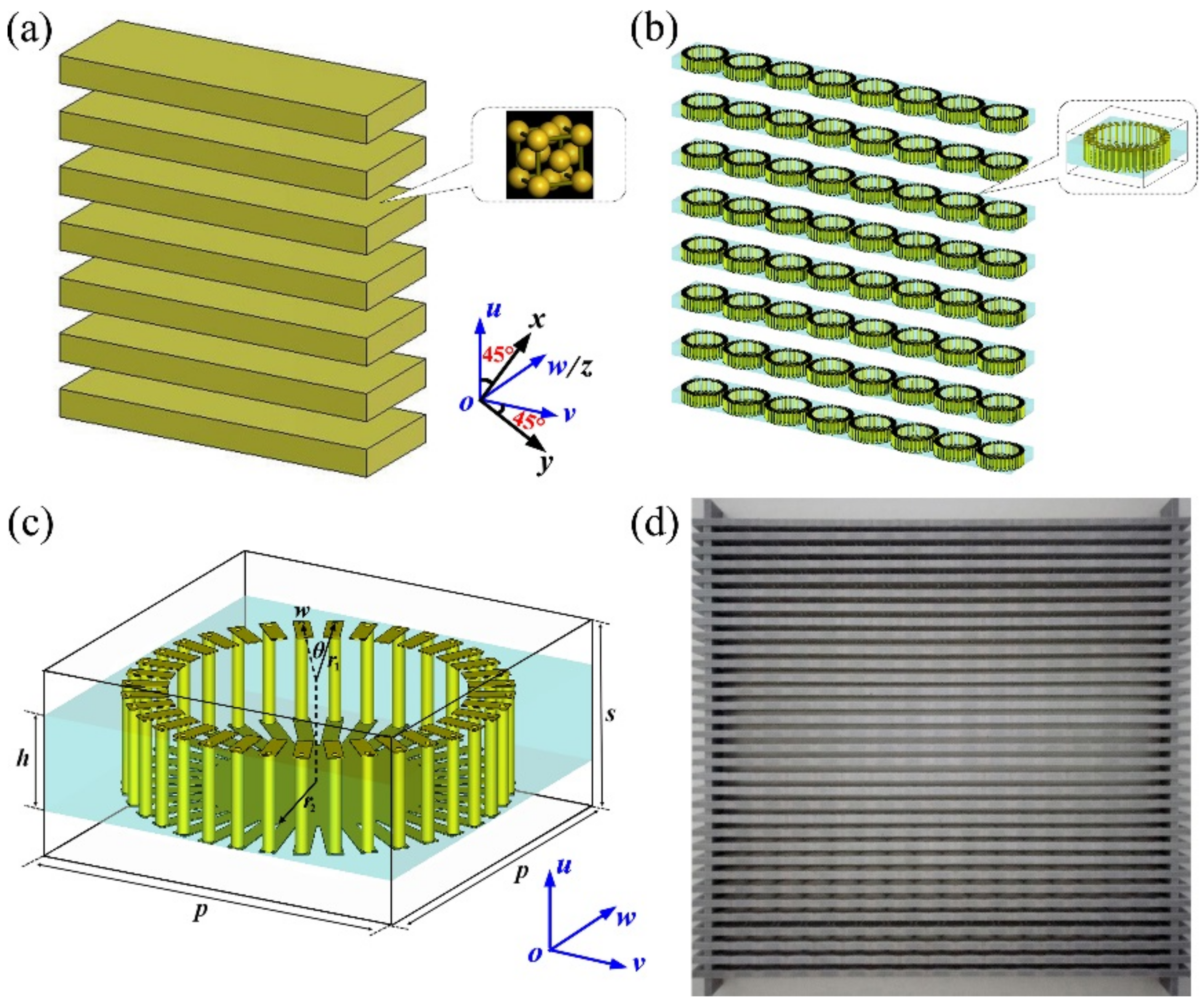

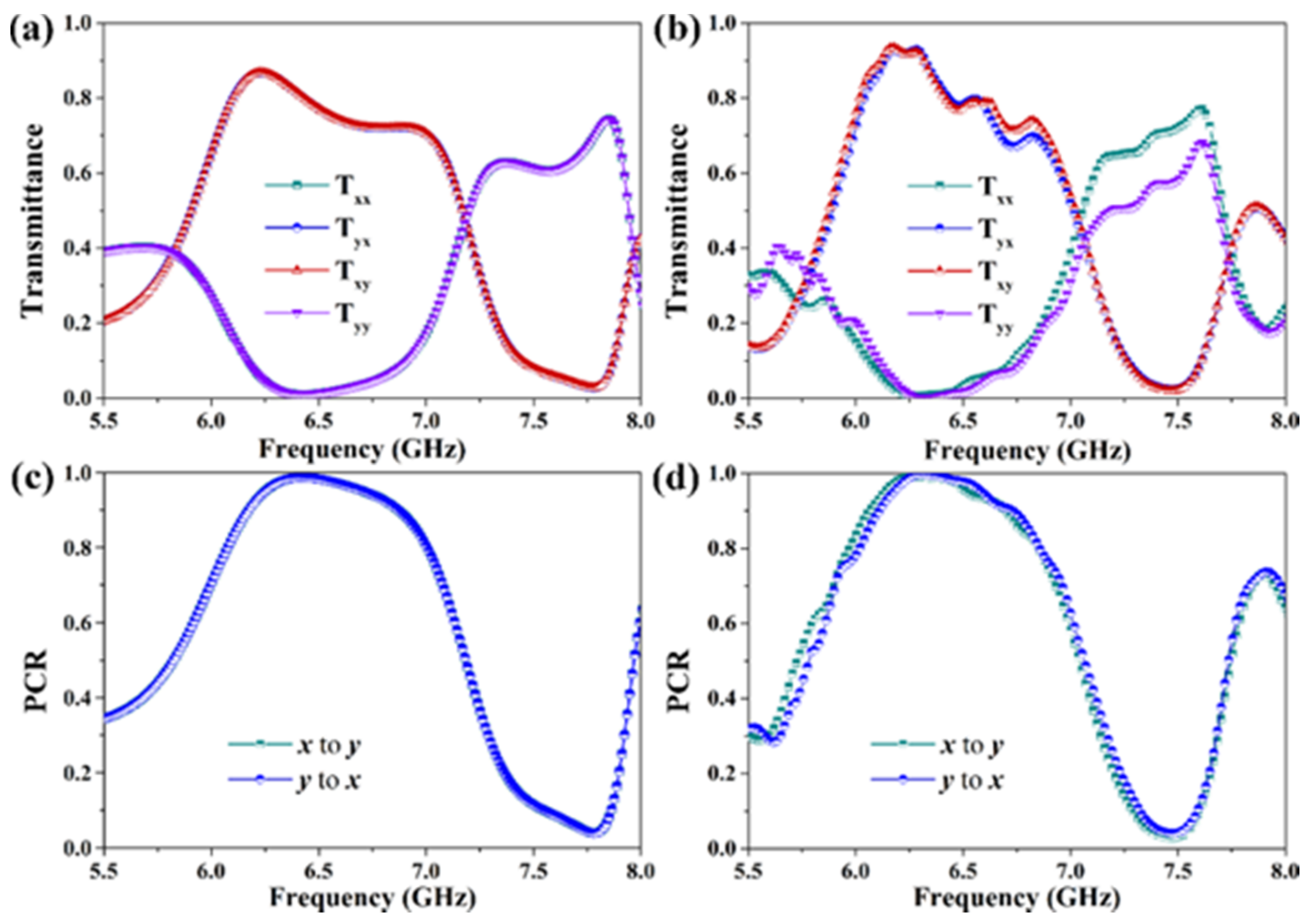
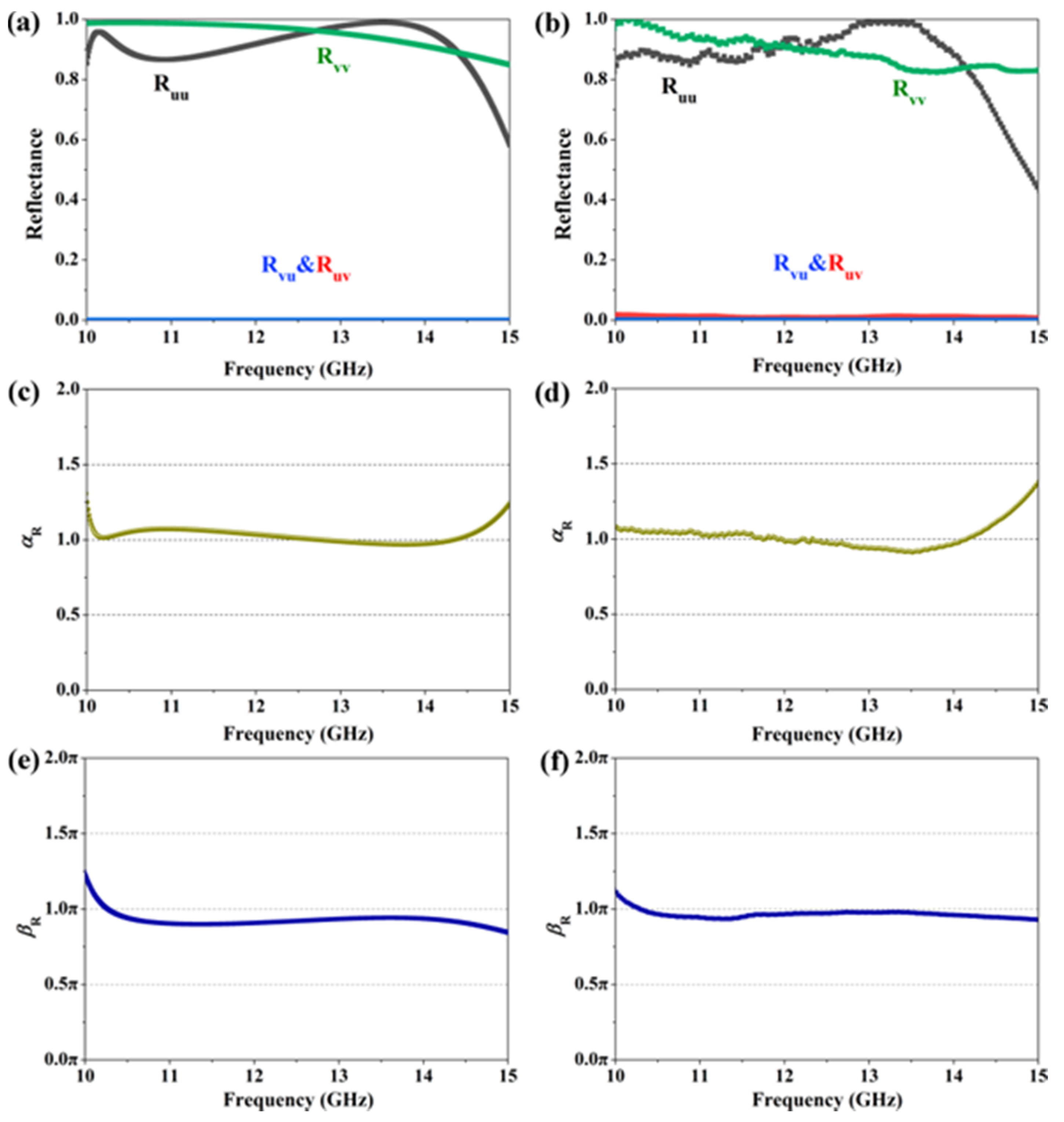
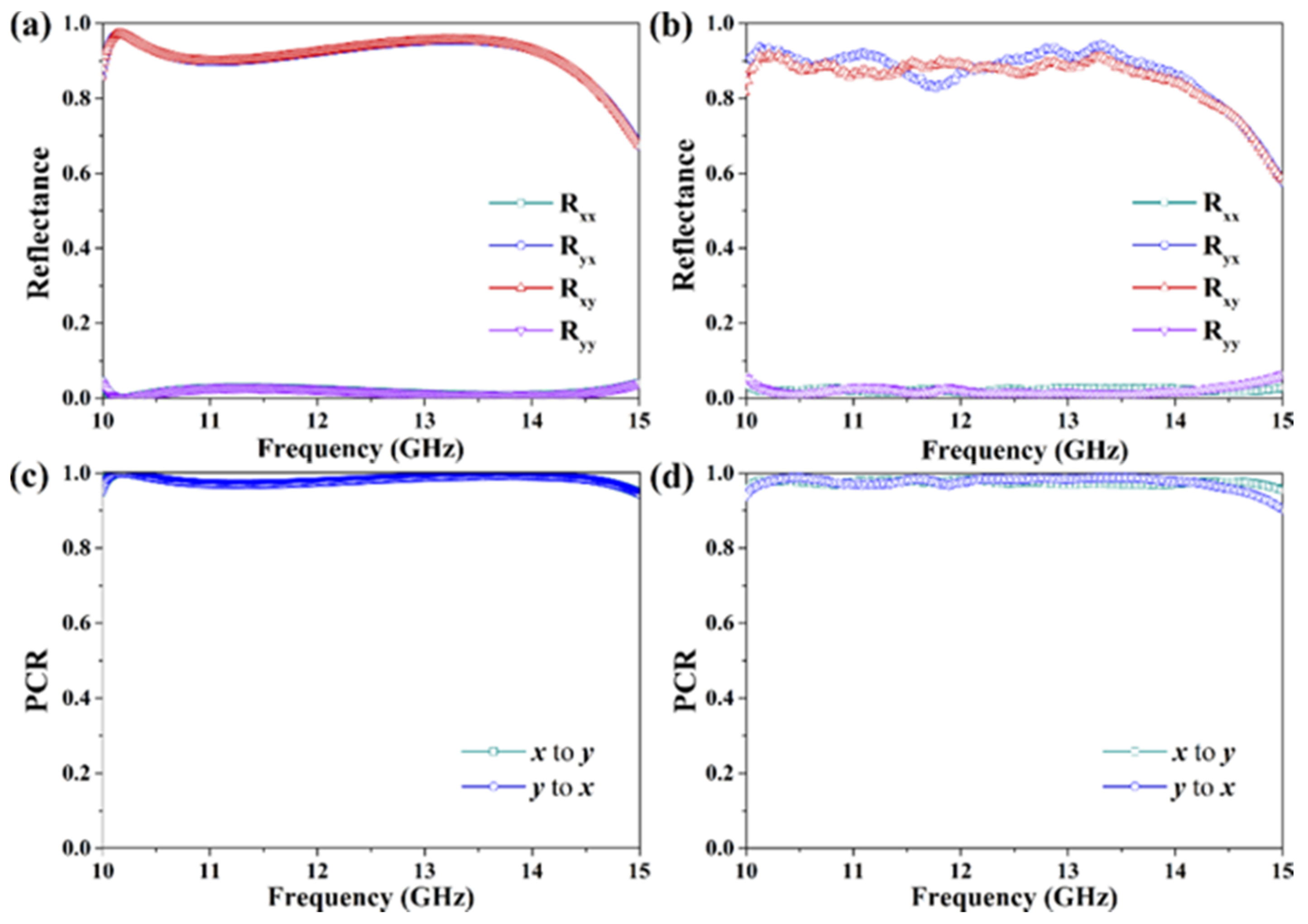

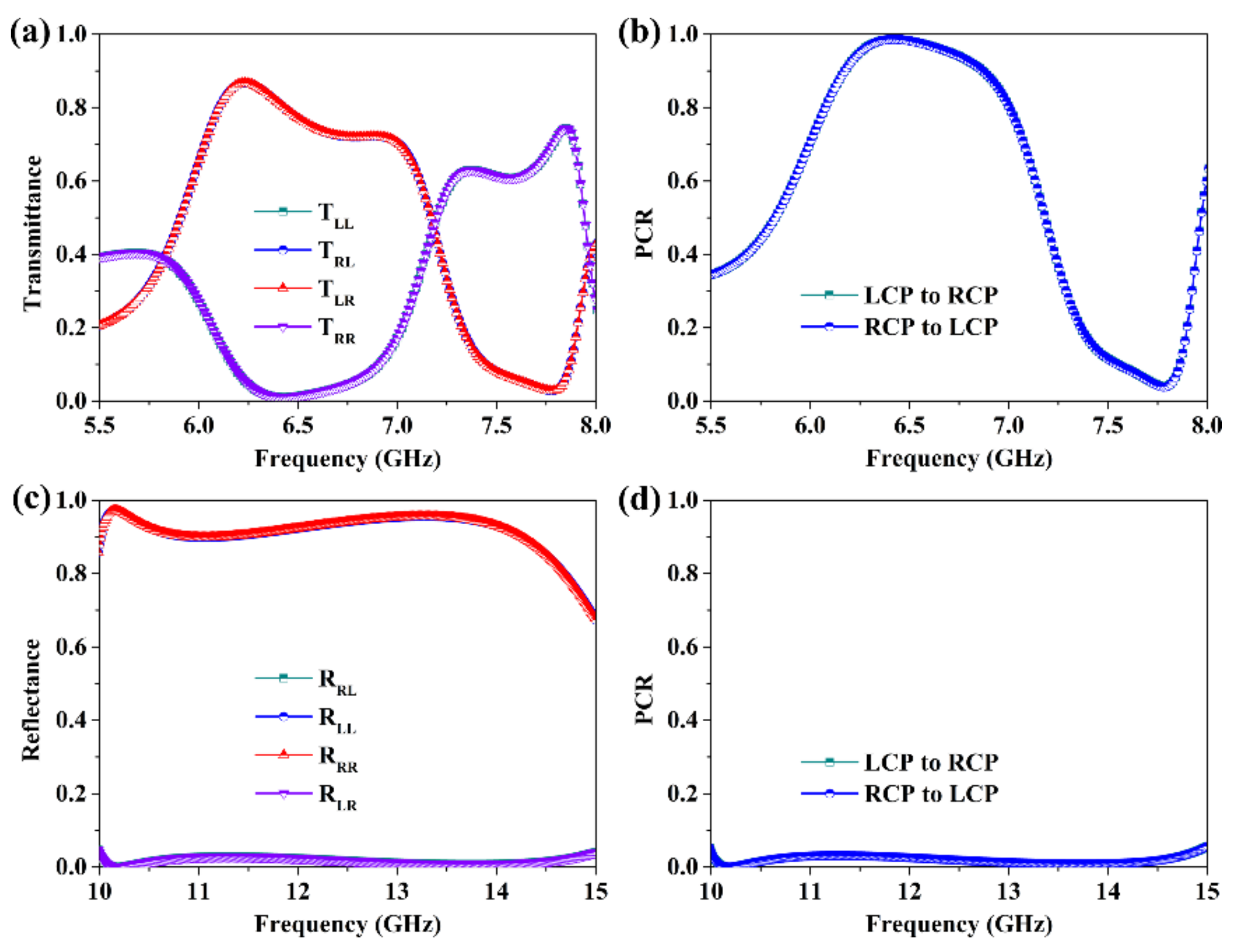
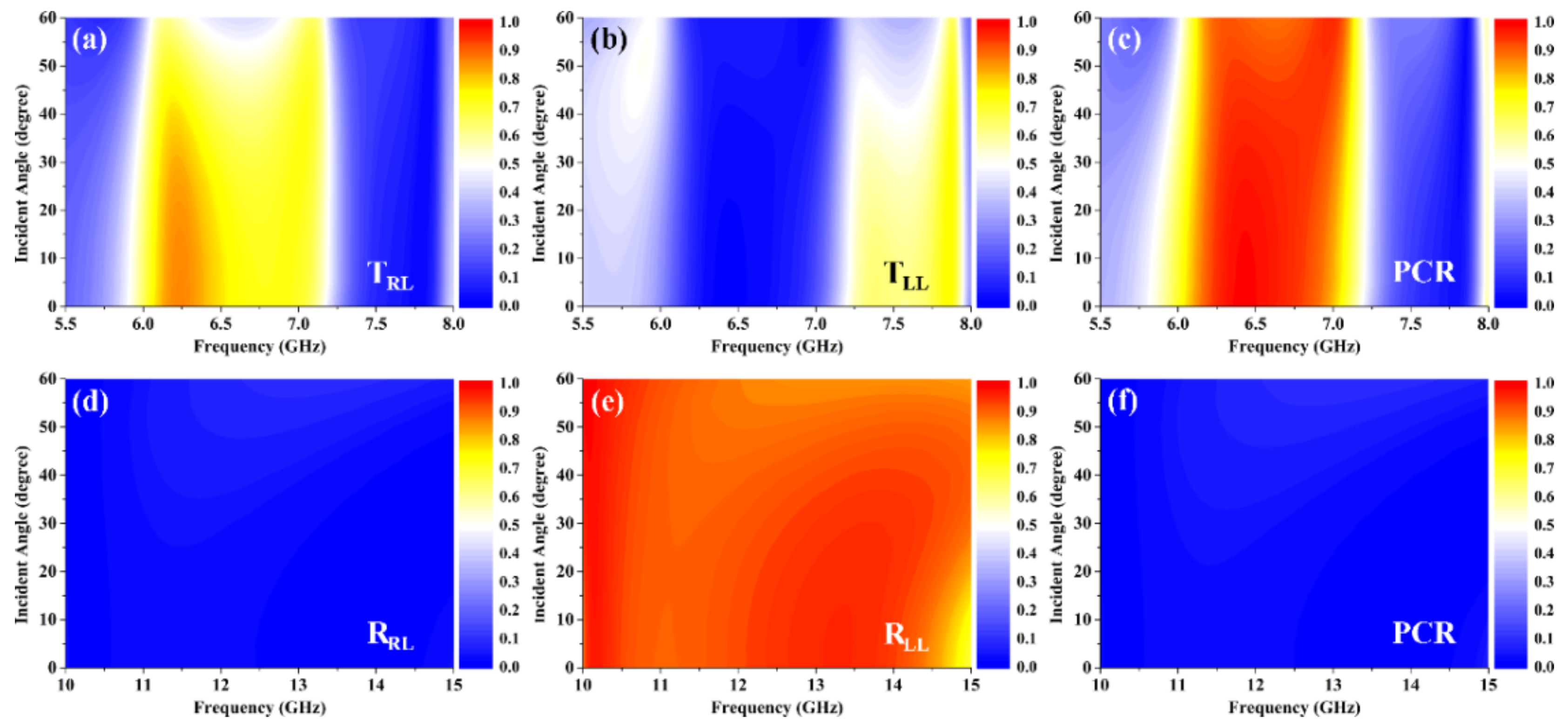
© 2019 by the authors. Licensee MDPI, Basel, Switzerland. This article is an open access article distributed under the terms and conditions of the Creative Commons Attribution (CC BY) license (http://creativecommons.org/licenses/by/4.0/).
Share and Cite
Song, K.; Ji, R.; Shrestha, D.; Ding, C.; Liu, Y.; Zhu, W.; He, W.; Liu, H.; Guo, Y.; Tang, Y.; et al. High-Efficiency and Wide-Angle Versatile Polarization Controller Based on Metagratings. Materials 2019, 12, 623. https://doi.org/10.3390/ma12040623
Song K, Ji R, Shrestha D, Ding C, Liu Y, Zhu W, He W, Liu H, Guo Y, Tang Y, et al. High-Efficiency and Wide-Angle Versatile Polarization Controller Based on Metagratings. Materials. 2019; 12(4):623. https://doi.org/10.3390/ma12040623
Chicago/Turabian StyleSong, Kun, Ruonan Ji, Duman Shrestha, Changlin Ding, Yahong Liu, Weiren Zhu, Wentao He, Huidong Liu, Yuhua Guo, Yongkang Tang, and et al. 2019. "High-Efficiency and Wide-Angle Versatile Polarization Controller Based on Metagratings" Materials 12, no. 4: 623. https://doi.org/10.3390/ma12040623
APA StyleSong, K., Ji, R., Shrestha, D., Ding, C., Liu, Y., Zhu, W., He, W., Liu, H., Guo, Y., Tang, Y., Zhao, X., & Zhou, J. (2019). High-Efficiency and Wide-Angle Versatile Polarization Controller Based on Metagratings. Materials, 12(4), 623. https://doi.org/10.3390/ma12040623





